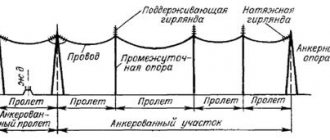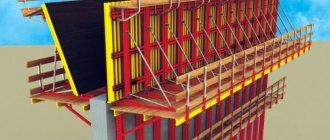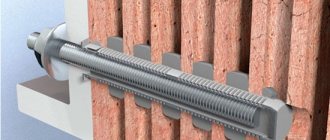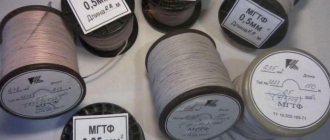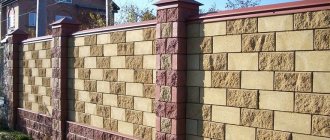Main characteristics of concrete rings
For concrete rings, important characteristics that affect ease of use and service life are:
- The material from which the ring is made. To produce these structures, various grades of concrete are used (preferably those above 500 in number), crushed stone, polymer sand mixtures, polymer admixtures and a reinforcing mesh made of steel rod. These materials are characterized by high strength and are also resistant to aggressive environmental conditions and moisture.
- Ring size. The standard height for most concrete rings is 90 cm. The diameter varies from 70 to 200 cm, and the wall thickness is from 8 to 12 cm. Also, structures of non-standard sizes, which are made individually, can be used for construction work.
Characteristics
The ease of use and service life are affected by the following characteristics of concrete rings:
- Material . The structures are made from two types of raw materials. The classic option is concrete products marked M200-M500, reinforced with a welded lattice made of steel rod with a diameter of 6-10 mm. The second type is made from polymer-sand mixtures with improved strength and service life.
- For molding, a split vibroform or a stationary vibropress is used. Strong vibration helps to compact the material and create a solid part. After manufacturing, the rings are left to gain strength at the site of formation or placed in a steaming chamber for the same purpose.
- Dimensions . They are varied enough to be suitable for use in different projects. The standard height of popular products is 90-100 cm, wall thickness varies between 8-12 cm, diameter - 70-200 cm. There are designs of non-standard sizes for highly specialized tasks, individual production is possible.
Ring sizes are determined by three parameters Source v-srok.ru
- Weight . Without taking it into account, it is impossible to make calculations when designing, transport rings and assemble a structure from them. The weight of a 1 m reinforced concrete ring is different for each brand and depends on the dimensions: height, internal diameter, wall thickness, as well as the type of concrete.
- Construction type . Straight products with smooth edges are connected using cement mortar. Locking versions have a ring-shaped projection on one side that fits into a notch on the bottom. The locking connection turns out to be more reliable, the probability of displacement due to soil pressure tends to zero.
Advantages and disadvantages
The advantages of concrete rings for use in construction purposes are the following design properties:
- long service life (more than 10 years);
- affordable price;
- easy installation due to the correct geometric shape;
- high strength and operational reliability.
However, despite having a number of advantages, concrete rings have two significant disadvantages:
- additional costs for delivery and installation - the heavy weight of the structure will not allow you to install it yourself, so the services of special equipment will be required;
- Uneven load on the large mass of the ring can lead to the formation of chips and cracks.
Advantages and disadvantages
Reinforced concrete rings are an indispensable element of construction with the following advantages:
- Long service life . Standard industrial rings are designed to last 50 years. In fact, the average service life is longer: wells built more than 60-70 years ago are currently functioning.
- Wide range of sizes.
- Installation is simple due to the correct geometric shape. You can quickly install a sewer or water supply system.
Installation of wells for a septic tank Source pinimg.com
See also: Catalog of companies that specialize in water supply, sewerage and related work
- Structural rigidity . Wells can be installed on any soil, including problematic (unstable) soil.
- Reliability of operation . The weight of the well ring ensures high structural strength
- Reliability of the design . If the installation technology is followed, the seams fit tightly and become airtight.
- High quality is pleasantly correlated with an affordable price.
The large weight of the ring ensures its strength, but it also causes the following disadvantages:
- Delivery and installation will require additional costs. You cannot do without the services of special equipment.
- If the load on the structure is higher than the calculated one , cracks and chips may form, and the tightness will be compromised.
For loading and unloading you need a crane. Source ibud.ua
Types of rings
Concrete rings are classified according to the type of structural design of standard sizes and according to GOST standards.
According to the type of structural design of standard sizes, the diameter of the rings varies in the range from 7 to 20 dm, and their height – from 1 to 10 dm.
According to standardized standards, concrete rings are produced in the following types:
- Auxiliary (KO). They are made to order if a ring of a non-standard size or shape is required. Both types of auxiliary wheels, additional and support, are used when installing complex technological objects, drainage systems, as well as for arranging utility turns and when constructing a well neck.
- Prefabricated. Such structures are manufactured only in factory conditions, so they will be used successfully and for a long time in any conditions. They have improved technical characteristics, fire resistance, as well as increased frost resistance and protection against corrosion.
- Wall (KS). These rings do not contain additional fasteners, so they are most often used as well necks. They are easy to install: the rings are alternately laid on top of each other and the seams are sealed using concrete mortar.
- With bottom (PN). Such structures are equipped with a sealed bottom that does not allow water to pass through. They are most often used for the construction of sewer and septic wells, as well as settling chambers. The bottom can provide protection from groundwater to the rest of the structure, as well as prevent harmful substances from entering the soil from the concrete tank.
- With a lock. Concrete rings with a lock are a fairly reliable design that allows you to ensure tightness of joints and increase resistance to environmental factors.
- With floor slab (PP). Such rings are best suited for installing deep wells. The floor slab will give the concrete structure greater strength and reliability in use.
Features of installation and operation
Some sizes of concrete rings are up to 70–200 kg, which allows them to be laid manually or using homemade devices. Special equipment will be needed if the additional equipment weighs 1,000–1,500 kg.
In this case, concrete rings with a lock are sealed with construction mixtures, as well as jute. If necessary, the inside is coated with a deep penetration primer, and then covered with mixtures that increase water resistance (entirely or just the joints). The simplest primer for reinforced concrete is a solution of PVA glue in water (1 to 8).
During operation, it is important to monitor the condition of the joints: they will be the first to show shifts in soil masses and the possible need for excavation work. Joints must be regularly sealed - using primer, jute, etc.
Restoration of reinforced concrete structures consists of sealing the ring with a lock and further filling the crack with concrete with pre-treatment with a deep-setting primer. If necessary, metal staples are applied to the crack.
Sizes of structures
The selection of the required size of a concrete ring should be made depending on the type of structure for which it will be used.
For example, when selecting a ring for a drinking well, it is recommended to first calculate the volume of water that is consumed. The greater the water consumption, the wider the diameter of the ring should be. And only after that the required size of the structure is selected based on the internal diameter.
In order to avoid installation problems due to incorrect selection of diameter, you should pay attention to the ring markings. In it, the manufacturer indicates all the necessary characteristics.
For example, a concrete wall ring of grade KS-10−9 has an internal diameter of 10 dm (100 cm) and a height of 90 dm (90 cm).
Wall rings
| Type | Outer diameter, mm | Inner diameter, mm | Height, mm | Wall thickness, mm | volume, m3 | Weight, t |
| KS 7.6 | 840 | 700 | 590 | 70 | 0.3 | 0.25 |
| KS10.18a | 1160 | 1000 | 1790 | 80 | 0.46 | 1.15 |
| KS10.3 | 290 | 0.08 | 0.2 | |||
| KS10.6 | 590 | 0.16 | 0.4 | |||
| KS10.9 | 890 | 0.24 | 0.6 | |||
| KS10.9a | 0.22 | 0.55 | ||||
| KS13.6 | 1410 | 1250 | 590 | 0.2 | 0.5 | |
| KS13.9a | 890 | 0.28 | 0.7 | |||
| KS13.9b | 0.24 | 0.6 | ||||
| KS15.18 | 1680 | 1500 | 1790 | 90 | 0.804 | 2.01 |
| KS15.6 | 590 | 0.265 | 0.66 | |||
| KS15.6b | 0.22 | 0.55 | ||||
| KS15.9 | 890 | 0.4 | 1 | |||
| KS20.12a | 2200 | 2000 | 1190 | 100 | 0.67 | 1.68 |
| KS20.12b | 0.64 | 1.6 | ||||
| KS20.18b | 1790 | 1.02 | 2.55 | |||
| KS20.6 | 590 | 0.39 | 0.98 | |||
| KS20.9 | 890 | 0.59 | 1.48 | |||
| KS25.12a | 2700 | 2500 | 1190 | 0.87 | 2.18 | |
| KS25.12b | 0.76 | 1.90 | ||||
| KS25.6 | 590 | 0.48 | 1.2 |
Also, when installing a concrete structure, its height plays an important role. Since the smaller it is, the more joints will need to be sealed. However, in the opposite case, if the ring is very tall, then installing it will be more difficult due to its enormous weight.
Support rings
| Type | External diameter, mm | Inner diameter, mm | Height, mm | Concrete volume, cubic meters | Weight, t |
| K-1 | 840 | 700 | 180 | 0.053 | 0.13 |
| KO1 | 900 | 600 | 100 | 0.045 | 84 |
| KO4 | 840 | 580 | 40 | 0.02 | 40 |
| KO6 | 840 | 580 | 70 | 0.02 | 0.05 |
Bottom plates
| Name | Diameter D, mm | Thickness h, mm | Concrete volume, cubic meters | Weight, tons |
| Mon 7 | 840 | 100 | 0.12 | 0.09 |
| PN10 | 1500 | 100 | 0.18 | 0.45 |
| PN15 | 2000 | 120 | 0.38 | 0.95 |
| PN20 | 2500 | 120 | 0.59 | 1.48 |
| PN25 | 3000 | 140 | 0.98 | 2.45 |
Product dimensions: height, diameter, weight, volume in cubes
Depending on the material (concrete, reinforced concrete), its brand, height, wall thickness. The dimensions of concrete rings for wells are determined by their purpose. Below are the most applicable options for reinforced concrete structures, indicating the main parameters and weight:
| Product brand code | Purpose | Dimensions (wall thickness, material consumption) for reinforced concrete parts of the well |
| KS 7-9 | Small-diameter underground communications: sewerage, drainage, wells, gas | H = 90 cm; D = 70 cm; T (wall thickness) = 9 cm; weight – 380 kg; volume – 0.628 m3; concrete volume – 0.15 m3 |
| KS 10-9 | Pumps, caissons for fire hydrants, drinking and waste wells. Most used on private plots | H = 90 cm; D = 100 cm; T = 9 cm; weight – 600 kg; volume – 1.198 m3; concrete volume – 0.24 m3 |
| KS 15-9 | Industrial pipelines, gas and sewer wells | H = 90 cm: D = 1.5 m; T = 9 cm; weight – 1000 kg; volume – 4.31 m3; concrete volume – 0.4 m3 |
| KS 20-9 | Cesspools, storm drains, main communications | H = 90 cm; D = 2 m; T = 9 cm; weight – 1480 kg; volume – 6 m3; concrete volume – 0.59 m3 |
Manufacturing technology
The technological process for manufacturing concrete rings consists of three stages:
- Installation of drop-down formwork and frame. A strong cylindrical shape (preferably made of steel) is marked on the outside with two horizontal lines that will divide the entire diameter of the shape in half. The cylinder is cut along one line. Window or door awnings are attached to these lines in two pieces. Special fittings are used to connect the halves. On the second cylindrical form, which is smaller in diameter, markings are made similarly to the large form, and canopies and spindles are also attached. The hinged parts are assembled in such a way that the internal structure is 1 dm higher than the external formwork. Thus, the outer cylinder should open outward, and the inner cylinder inward.
- Filling the mold with concrete and compacting the mass. A reinforcing frame made of steel reinforcement or metal mesh is poured with concrete in portions in a support ring. Each layer is carefully compacted to remove air. Due to this, the finished product becomes more durable. To compact the mixture, it is better to use an area vibrating device or a hammer drill. At the forming stage, four loops of wire are installed on the concrete blank, and its ends are bent and buried into the concrete by 4–5 dm. To prepare the filling, use a high-grade mixture of grade M500 and higher numbered.
- Dismantling. On the outer formwork, first unscrew the bolts. After the wall of the form is tapped with a hammer to better separate it from the concrete workpiece.
Making rings at home
Making concrete rings yourself at home will be useful if a person needs at least a dozen rings for construction purposes. If you need fewer of them, it is recommended to purchase ready-made products.
The technology for producing a concrete ring at home will be as follows:
- Stiffening ribs are welded to the ends of a durable steel casting mold, which consists of two rings, and connecting plates or unnecessary door panels are attached along the entire length. Before concreting, the plates or canvases are pulled together in half rings into a single structure.
- To raise and lower the rings using a crane, four mounting loops are installed in the mold and their curved ends are deepened into the concrete.
- The production of a concrete mixture begins with mixing a solution consisting of three components: 3 parts sand, 1 part cement and 1 part crushed stone. Water is added in small portions until the concrete mixture reaches a uniform thick consistency. The working consistency should be such that it is evenly distributed inside the mold.
Reference! You don’t have to prepare the concrete yourself, but use high-quality cement, the grade of which is not lower than 500.
- Fine aggregate (crushed stone “seed” with a fraction of 5–10 mm and washed sand) is added to the finished concrete mixture. It will give the concrete strength and a uniform structure.
- Concrete is poured into molds gradually in small portions. It is best to use a platform vibrator, which will remove air bubbles and voids. This equipment will increase the strength of concrete. If you don’t have it in your arsenal, you can use a regular hammer drill. To do this, it is necessary to sequentially press the body of the switched-on tool into different places on the outer part of the mold. As a result of these actions, vibration will be transmitted through the metal to concrete, and it will begin to settle and compact.
Attention! In the cold season, when the temperature drops below 5ºC, it is necessary to use electric heating of the mold. Otherwise, the concrete structure will turn out to be of poor quality and filled with voids.
- After the concrete has hardened in the mold, the outer part of the formwork is first removed. To do this, remove the bolts and tap the walls of the mold with a hammer. It will be easier to remove the inner part if you supply two additional square pipes, which can be knocked out to remove the inner shape.
